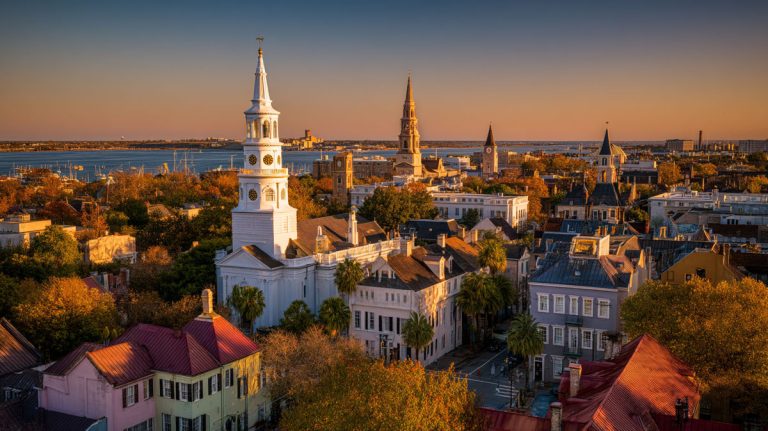Leaving New York City for Charleston means trading subway rushes for salt marsh mornings and cobblestone strolls. The Lowcountry greets you with warm weather, tidal creeks, and neighborhoods where the corner restaurant knows your order by week two. Historic streets meet new industry, so you can keep a New Yorker’s pace during the day and still catch a sunset over the harbor.
Plan your move with a clear budget and timeline, and you can step into a new home that fits the way you live. The guide below walks you through the essentials so settling in feels easy.
Why Relocating from New York City Makes Sense
Charleston sits on a busy harbor with Sullivan’s Island and Folly Beach minutes away. Steady growth in aerospace, healthcare, and tech keeps the city lively and opens doors for newcomers. If you love galleries, theater, and great food, you will find them here, then switch gears to kayaking on Shem Creek or biking the West Ashley Greenway.
The pace is calmer than Manhattan, but the city still has energy at night. Waterfront Park and the French Quarter stay active, while places like Mount Pleasant put big errands and quick downtown access in the same zip code. A backyard for a grill or garden is realistic without walking away from city amenities. You will swap snow days for hurricane planning, which is mostly preparation and good timing.
What is the Charleston, SC Real Estate Market Like?
Charleston’s for-sale market is active, and conditions shift by neighborhood. As of September 2025, the city’s median sale price was about $615,000, up 1.9% year over year, with a 76-day median to go under contract. That suggests balanced to slightly lean inventory depending on price point and location.
Zillow’s typical home value for the city hovered near $579,510 in late 2025 and many listings went pending in around seven weeks. Rents run above the national average in the core. Zillow’s observed rent data placed the city in the low $2,100s per month in September 2025.
What is the Cost of Living in Charleston Compared to NYC?
Every day costs trend closer to the national average in the South. National CPI rose about 3.0% over the year to September 2025, and the South region’s August 2025 report showed a 0.3% monthly increase across most categories. Groceries, dining, and transportation usually land lower than what you pay in NYC.
Taxes work differently, too. South Carolina’s top individual income tax rate is 6% for Tax Year 2025, compared to New York City residents, who face a combined state and city rate that can exceed 14% when the state’s top bracket and city income tax are added together. Even at moderate income levels, most New Yorkers pay nearly double what they would in South Carolina.
What are the Utilities in Charleston?
Dominion Energy South Carolina provides most electric and natural gas service, and you can start or transfer online with a service address and basic ID. Most City of Charleston addresses use Charleston Water System for water and sewer, which also supports online start or stop requests.
Mount Pleasant addresses use Mount Pleasant Waterworks. The City of Charleston and Charleston County publish trash and recycling schedules, with weekly pickup common for single-family homes.
Is Charleston Safer than NYC?
Neighborhood context matters, so rate-based comparisons help. Recent per 100,000 figures show New York City’s violent-crime rate in the mid-600s for 2024, based on statewide index definitions. Charleston’s 2024 police report noted a 5.7% decrease in violent crime over 2023, with declines across several categories.
In plain terms, NYC’s citywide violent-crime rate sits higher than Charleston’s trend, while individual categories can differ by place and year.
What is the Weather Like in Charleston?
Charleston has a humid subtropical climate with long warm seasons and short, mild winters. Summers run hot and humid with afternoon storms. Winter cold snaps are brief and snow is rare.
Outdoor time is part of the rhythm. Spring and fall are perfect for the beach, boat days, and farmers markets. If you miss big green space, Hampton Park and James Island County Park fill that role for runs, picnics, and kayak launches.
How are the Schools in Charleston?
Charleston County School District oversees most public schools in the city, with nearby districts serving the wider metro. The South Carolina Department of Education posts annual School Report Cards with accountability ratings, graduation metrics, and academic progress. In 2024 and 2025 releases, many CCSD schools earned Good or Excellent ratings, with others showing year-over-year gains.
Families also consider charter and magnet choices, plus private and parochial options. Use the state report cards for a data baseline, then visit schools and speak with administrators about programs like career pathways, advanced coursework, and arts.
What are the Job Opportunities in Charleston?
The economy leans on aerospace, advanced manufacturing, healthcare, defense, port logistics, software, and tourism. Boeing, Joint Base Charleston, the Medical University of South Carolina, and Roper St. Francis are among the largest employers. The Charleston Regional Development Alliance tracks sector growth and employer counts.
BLS wage data released in May 2025 shows an average hourly wage of $29.65 for the metro, with management, computer and mathematical, and healthcare occupations among the higher paid groups. Unemployment has hovered in the mid 3% range through summer 2025, which signals steady demand. New arrivals from New York often combine in-office roles in North Charleston or the port corridor with hybrid or remote work tied to NYC firms.
What is Transportation Like in Charleston?
The metro is car-friendly. I-26 links the peninsula to Summerville and Columbia, and bridges connect downtown to Mount Pleasant and James Island. CARTA runs a regional bus service and the free Downtown Area Shuttle circulates on the peninsula for errands, campus runs, and museum stops. Charleston International Airport set a 2024 passenger record near 6.3 million, with routes that make NYC a simple trip.
Rideshare coverage is broad in the core. Bike infrastructure keeps expanding, and the Ravenel Bridge path gives cyclists a dramatic link between downtown and Mount Pleasant.
What is the Lifestyle Like in Charleston?
Life tilts outdoors. People walk the Battery at sunrise, grab shrimp and grits at lunch, and end the day with live music or a quiet porch swing. County parks offer trails, boat launches, and shaded playgrounds. The atmosphere is friendly without feeling small. You will bump into neighbors at farmers markets and run into coworkers at the beach.
Compared with inland South Carolina metros, Charleston layers in coastal choices. For quieter streets near parks, look at James Island or West Ashley. For city energy, stay close to King Street. A New Yorker who likes options will settle in quickly with a plan for summer heat and festival weekends.
What are the Shopping and Dining Options in Charleston?
Boutiques, galleries, and national brands share space across the peninsula and Mount Pleasant. Upper King Street brings design shops and coffee bars. Mount Pleasant adds Towne Centre, Indigo Square, and other retail clusters. Farmers markets in downtown and on Johns Island run much of the year.
Dining is a local sport. Expect oysters, she-crab soup, and seasonal seafood across the peninsula. Neighborhood spots in Park Circle and James Island lean into local produce. Craving NYC variety is normal, and you will find sushi, ramen, and bakeries from chefs who chose the Lowcountry pace without leaving ambition behind.
What Are the Best Things to Do in Charleston?
Start on the water. A harbor cruise frames the Ravenel Bridge and Fort Sumter from the best angle. Beach days on Sullivan’s Island or Folly Beach are easy wins. South of Broad invites slow walks for architecture and hidden gardens. The International African American Museum adds depth to any weekend plan. County parks fill the calendar with kayak launches and bike loops.
Weekends get busy. Expect food festivals, art fairs, road races, and concerts from downtown to North Charleston’s coliseum district. When you want quiet, a porch swing and a creek view do the trick.
Charleston, SC FAQs
Where do recent arrivals from NYC often locate in the Charleston area?
Mount Pleasant attracts newcomers who want quick beach access and established shopping. James Island and West Ashley appeal to buyers seeking value with a short hop to downtown. Daniel Island offers trails and a central town area. Narrow choices by commute, school considerations, and budget.
How do Charleston housing costs compare to the national average?
For-sale prices and rents sit above the national average but below top NYC submarkets. In September 2025 the city’s median sale price was near $615,000 and typical rent landed in the low $2,100s based on Zillow’s index. Neighborhood and property type drive the final number.
What is daily transportation like without a subway?
CARTA covers major corridors and the free DASH helps on the peninsula. Most residents still keep a car for cross-river trips, school runs, and beach days. With added routes at the airport, quick flights back to NYC are straightforward.
Are utilities straightforward to start when you arrive?
Yes. Dominion Energy handles most electric and gas connections. Water and sewer are typically through Charleston Water System or Mount Pleasant Waterworks depending on address. You can start service online and match your move-in date. AT&T Fiber and Xfinity are the common internet providers.
What job sectors are hiring in the Charleston metro?
Aerospace, advanced manufacturing, port logistics, healthcare, tourism, and software continue to add roles. Employers like Boeing, MUSC, and Joint Base Charleston anchor demand. Unemployment in the metro stayed in the mid 3% range through late summer 2025, which points to steady opportunities across skill levels.






